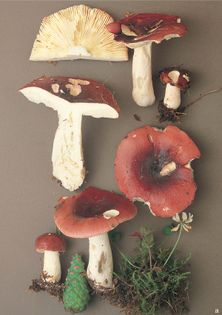Crab Brittlegill Russula xerampelina (Schaeff.) Fr. (illustrated 50% life size) Cap 5–14 cm across, convex, later flattening and with a depression, margin eventually furrowed; colours very varied, often mixed, dull purples, reds, wine-coloured; moderately firm, sometimes hard, soon dry and matt; at most one-quarter peeling. Stem 30–110×10–30mm; white or tinted rose, staining honey to brownish-ochre, especially on bruising, reacting dull green when rubbed with iron salts; firm to hard. Flesh white; taste mild, smell crab-like, especially with age. Gills adnexed, fairly broad and thick, connected by veins at their bases; pale to medium ochre. Spores 8–11×6.5–9µ, ovate; warts up to 1.2µ high, lines none or few, occasionally enclosing a mesh. Spore print deep cream to pale ochre (E–F). Cap cystidia infrequent, mostly narrow, not reacting to SV; cap hyphae with terminal cells sometimes club-shaped, these and the supporting cells inflated. Habitat with broad-leaved trees, especially beech and oak; late summer to late autumn. Common. Edible. Note this is an unresolved complex, which is divided by some authorities into a number of different species and varieties. Some of the specimens shown under this name in my first book have now been moved to follow updated nomenclature (R. langei R. graveolens p.). In my first book I named the laid-out collection (a) as R. erythropus. Note field photograph (d) was taken by Geoffrey Kibby.




